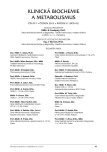The risk of transformation in monoclonal gammopathy of undetermined significance in malignant monoclonal gammopathy
Authors:
V. Maisnar
Authors‘ workplace:
IV. interní hematologická klinika, FN a LF UK Hradec Králové
Published in:
Klin. Biochem. Metab., 21 (42), 2013, No. 2, p. 93-96
Overview
Monoclonal gammopathy of undetermined significance (MGUS) is defined as a clinically silent symptomless condition where not met diagnostic criteria for multiple myeloma, Waldenström macroglobulinemia, AL-amyloidosis or other malignant lymphoproliferative disease. Long-term monitoring has shown that it is possible to premalignant progression to malignant monoclonal gammopathy in approximately 1% of cases a year, probably all cases of MM arise transformation from MGUS. Within an easy communication, the author tries to answer the question whether it is currently possible to somehow transform MGUS in MM to prevent or at least slow down. The response in MGUS patients is not for now. Given the much higher level of risk of transformation in patients with asymptomatic multiple myeloma than in MGUS patients, further analysis CMG (Czech myeloma group) is focused on this group of patients with the aim to identify the highest risk patients and then subject them to early and, if possible, non-toxic treatment.
Keywords:
monoclonal gammopathy of undetermined significance (MGUS), diagnosis, prognosis, monitoring, therapy.
Sources
1. Attaelmannan, M., Levinson, S. S. Understanding and identifying monoclonal gammopathies. Clin. Chem., 2000, 46, p. 1230-8.
2. Kyle, R. A. Monoclonal gammopathy of undetermined significance and solitary plasmocytoma. Hematol Oncol. Clin. N. Am., 1997, 11, p. 71-87.
3. Kyle, R. A, Rajkumar, S. V. Monoclonal gammopathy of undetermined significance. Br. J. Haematol., 2006, 134, p. 573-89.
4. Kristinsson, S. Y., Björkholm, M., Anderson, T. M. et al. Patterns of survival and cause of death following a diagnosis of monoclonal gammopathy of undetermined significance: a population-based study. Haematologica, 2009, 94, p. 1714-20.
5. Kyle, R. A., Lust, J. A. Monoclonal gammopathies of undetermined significance. Semin. Hematol., 1989, 26, p. 176-200.
6. Landgren, O., Kyle, R. A., Rajkumar, S. V. From mye-loma precursor disease to multiple myeloma: new diagnostic concepts and opportunities for early intervention. Clin. Cancer Res., 2011, 17, p. 1243-52.
7. Landgren, O., Waxman, A. J. Multiple myeloma precursor disease. JAMA, 2010, 304, p. 2397-404.
8. Durie, B. G. M., Kyle, R. A., Belch, A. et al. Myeloma management guidelines: a consensus report from the Scientific Advisors of the International Myeloma Foundation. Hematol. J., 2003, 4, p. 379-98.
9. Bird, J., Behrens, J., Westin, J. et al. UK Myeloma Forum (UKMF) and Nordic Myeloma Study Froup (NMSG): guidelines for the investigation of newly detected M-proteins and the management of monoclonal gammopathy of undetermined significance (MGUS). Br. J. Haematol., 2009, 147, p. 22-42.
10. Dispenzieri, A., Kyle, R., Mateos, M. V. et al. International Myeloma Working Group guidelines for serum free light chain analysis in multiple myeloma. Leukemia, 2009, 23, p. 215-24.
11. Kyle, R. A., Rajkumar, S. V. Monoclonal gammopathy of undetermined significance. Br. J. Haematol., 2006, 134, p. 573-89.
12. Kyle, R. A., Therneau, T. M., Rajkumar, S. V. et al. A long-term study of prognosis in monoclonal gammopathy of undetermined significance. N. Engl. J. Med., 2002, 346, p. 564-9.
13. Kyle, R. A., Durie, B. G. M., Rajkumar, S. V. et al. Monoclonal gammopathy of undetermined significance (MGUS) and smoldering (asymptomatic) multiple mye-loma, IMWG consensus perspectives risk factors for progression and guidelines for monitoring and management. Leukemia, 2010, 24, p. 1121-7.
14. Paiva, B., Vidriales, M. B., Perez, J. J. et al. Multiparametric flow cytometry quantification of bone marrow plasma cells at diagnosis provides more prognostic information than morphological assessement in myeloma patients. Haematologica, 2009, 94, p. 1599-602.
15. Perez-Persona, E., Vidriales, M. B., Mateo, G. et al. New criteria to identify risk of progression in monoclonal gammopathy of uncertain significance and smoldering multiple myeloma based on multiparametric flow cyto-metry analysis of bone marrow plasma cells. Blood, 2007, 110, p. 2586-92.
16. Lopez-Corral, L., Gutierrez, N. C., Vidriales, M. B. et al. The progression from MGUS to smoldering myeloma and eventually to multiple myeloma involves a clonal expansion of genetically abnormal plasma cells. Clin. Cancer Res. 2011, 17, p. 1692-700.
17. Bird, J. M., Owen, R. G., D´Sa, S. et al. Guidelines for the diagnosis and management of multiple myeloma 2011. Br. J. Haematol., 2011, 154, p. 32-75.
18. Kumar, S. K., Dingli, D., Lacy, M. Q. et al. Outcome after autologous stem cell transplantation for multiple myeloma in patients with preceding plasma cell disorders. Br. J. Haematol., 2008, 141, p. 205-11.
19. Maisnar, V., Radocha, J., Žák, P. et al. 15-years of single center experience with stem cell transplantation for multiple myeloma. Haematologica/Hematol. J., 2011, 96 (Suppl. 1), 89/P-201.
20. Mateos, M. V., San Miguel, J. S., Garcia-Sanz, R. et al. Results of QuiRedex study. Blood, 2010, 116, A-1935.
21. Bladé, J., Dimopoulos, M., Rosinol, L. et al. Smoldering (asymptomatic) multiple myeloma, Current diagnostic criteria, new predictors of outcome, and follow-up recommendations. J. Clin. Oncol., 2010, 28, p. 690-7.
22. Pérez-Persona, E., Mateo, G., Garcia-Sanz, R. et al. Risk of progression in smoldering myeloma and monoclonal gammopathies of unknown significance, comparative analysis of the evolution of monoclonal component and multiparameter flow cytometry of bone marrow plasma cells. Br. J. Haematol., 2010, 148, p. 110-4.
23. Kyle, R. A., Durie, B. G. M., Rajkumar, S. V. et al. A monoclonal gammopathy of undetermined significance (MGUS) and smoldering (asymptomatic) multiple myeloma: IMWG consensus perspectives risk factors for progression and guidelines for monitoring and management. Leukemia, 2010, 24, p. 1121-7.
Labels
Clinical biochemistry Nuclear medicine Nutritive therapistArticle was published in
Clinical Biochemistry and Metabolism

2013 Issue 2
Most read in this issue
- Clinical and laboratory aspects of biclonal gammopathy of undetermined significance - BGUS
- The role of bone metabolism parameters in the assessment of myeloma bone disease
- The risk of transformation in monoclonal gammopathy of undetermined significance in malignant monoclonal gammopathy
- Significant decrease of blood lead levels in lead-exposed workers due to effective preventive measures
